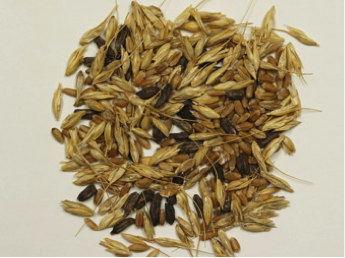It has been a long cold winter with record low temperatures. This has led to some growers wondering if they still have to worry about plant diseases this growing season. As cold as it has been this winter, it may not have been cold enough for plant pathogens to die. Fungal pathogens have survival structures that enable them withstand very harsh weather conditions.
Most of the important plant diseases in South Dakota survive on infested crop residues or in soil. They have hardened fungal bodies that can remain viable over a long time (greater than two years) and can withstand freezing temperatures. Plant residues and snow cover provide insulation in the top layer of the soil, therefore, even when the air temperature may be below freezing, soil temperatures will be slightly higher under these conditions.
Other fungal pathogens that do not survive the winter in South Dakota overwinter in warm areas in the southern states and the spores are dispersed by wind during the spring and summer to the northern states. Examples in this category are the cereal rusts including stem rust, leaf rust, and stripe rust.
For the soybean cyst nematode, winter mortality will depend upon the life development stage of the nematode. Research done on potato cyst nematode which has similar life cycle like the soybean cyst nematode showed that hatched juveniles could survive by supercooling if not in contact with water but could not survive in ice. The same research also showed that the unhatched juveniles inside the eggs could survive in ice.
The soybean cyst nematode unhatched juveniles have double protection: the female body (cyst) forms a tough protection sac around the eggs; and the egg shell also provides an additional layer of protection from harsh weather conditions. In addition, juveniles are stimulated to hatch by root exudates and also when temperatures are warm, therefore very few juveniles are present during the winter period. These mechanisms ensure that the cyst nematode survives well in winter conditions like we have had this winter.
For viral diseases, viruses overwinter either in alternative hosts (weeds, winter crops) or in their vectors. Therefore the extent of cold winter effects on virus survival depends on the survival of the hosts and the vectors. The vectors for the most important viruses in South Dakota are the wheat curl mite (WCM) which transmits three wheat viruses (Wheat streak mosaic virus, Triticum mosaic virus, and High Plains virus); and the bean leaf beetle which transmits Bean pod mottle virus (BPMV). The WCM can survive freezing temperatures for three months. However, the most damaging virus infections in wheat take place in fall. Additionally, the WCM is highly prolific, completing its life cycle in 10 days, hence a few WCM surviving the winter can give rise to a high WCM population in a short time.

Fig. 1. Ergot in wheat. The black sclerotia are thickened fungal survival structures that are mixed with normal wheat seed (Picture courtesy of Stephen Wegulo, UNL)
Winter temperatures, however, do affect bean leaf beetle winter survival. Research done at Iowa State University indicates that bean leaf beetles will die when air temperature is below 14 F. This winter, we had many days when air temperature was below 14 F, therefore, bean leaf beetle survival this winter is expected to be minimal. However, growers (especially in south-central South Dakota) should scout their fields for bean leaf beetles if there has been a history of bean pod mottle virus and soybeans are planted early.
Some pathogens can be seed-borne; such pathogen can either be on the seed surface, inside the seed or may be mixed with the seed in the case of ergot in small grains (Fig. 1) and sclerotia in many crops. In this case, these pathogens will not be affected by how cold the winter was provided the seed was stored well.
The extent to which plant diseases are going to develop this growing season will depend on spring and summer weather conditions (rainfall, relative humidity, temperature), the level of susceptibility of the cultivar being grown, and which cultural practices are being used (crop rotation, time of planting, drainage etc.) and less on how cold this winter was. Growers should consider the history of diseases for their fields, the cultivar to be planted, crop rotation and conditions at planting in order to gauge the likelihood of diseases to develop and then plan accordingly. Growers are also encouraged to scout their fields and consult the crop protection guides to help them decide on chemical protection for their crops.





